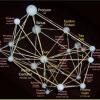LDL-C was decreased more potently in the LS than HS groups (-34% vs -19%; p=0.0069),
incidence of new Q-wave appearance in electrocardiogram was significantly lower (75% vs 89%; p=0.0056) in the HS(pravastatin; HS group; n=110)than LS(atorvastatin, fluvastatin, pitavastatin and simvastatin; LS group; n=131) groups.
CONCLUSIONS: In normocholesterolemic Japanese patients after AMI, hydrophilic pravastatin could be superior to lipophilic statins at preventing new Q-wave appearance and reducing cardiovascular events.
http://www.ncbi.nlm....pubmed/17721009
In the present study, pravastatin was the only hydrophilic
statin used, whereas several lipophilic statins were
administered: atorvastatin, fluvastatin, simvastatin and
pitavastatin. Hydrophilic statins are distributed much more
selectively in hepatocytes compared with lipophilic statins.17
Liver cellular membranes contain organic anion transporters
that mediate uptake of hydrophilic substances into
the cell. However, because extrahepatic cellular membranes
consist of lipid bilayers, hydrophilic statins cannot penetrate
these cellular membranes and thus cannot inhibit
intracellular HMG-CoA. Hence, whereas hydrophilic statins
are prevented from entering extrahepatic tissues, lipophilic
statins might inhibit not only cholesterol synthesis in the
liver but also production of essential substances by HMGCoA
reductase reaction, such as farnesylated proteins,
heme A, dolichol and ubiquinone (coenzyme Q10; CoQ10),
in peripheral compartments.17 CoQ10, an essential factor in
oxidative energy-generating systems in mitochondria, is
synthesized from mevalonic acid in many organs including
the heart.18 The mitochondrial inner membrane of heart
muscle has high activity of polyprenyltransferase, which
attaches isoprenoids to quinone bodies and is a key enzyme
in CoQ10 biosynthesis.19 It has been also reported that
upregulated CoQ10 biosynthesis in the heart is associated
with increased activity of HMG-CoA reductase.20 Lipophilic
statins that can enter easily myocardial cells inhibit isoprenoid
expression and thereby prevent CoQ10 biosynthesis in the
heart. This process could slow down mitochondrial generation
of ATP and affect myocardial contraction. Ichihara et
al reported that in a canine experimental myocardial ischemia
model, lipophilic statins worsened myocardial contractile
dysfunction during reperfusion, whereas pravastatin did
not.12,13 They also noted that worsening of myocardial
contraction was associated with reduction of myocardial
concentrations of CoQ10 and mitochondrial respiratory
function.21 Taken together, these mechanisms could explain
the superiority of hydrophilic vs lipophilic statins observed
in the present study.
Edited by brunotto, 25 December 2010 - 05:14 PM.














































